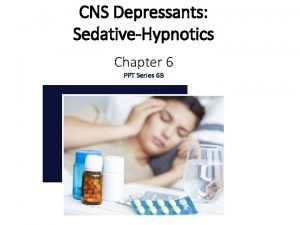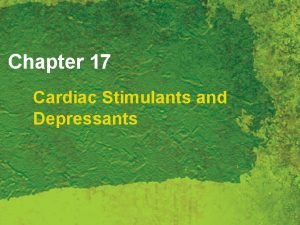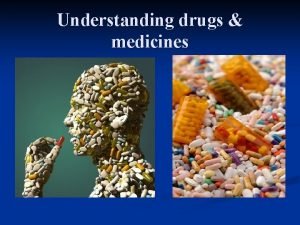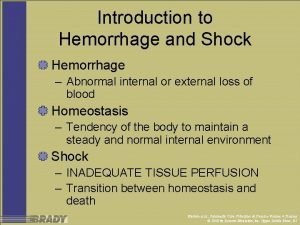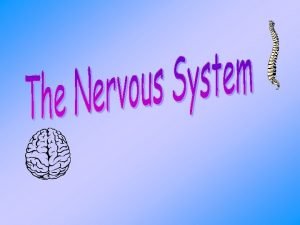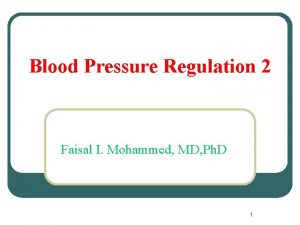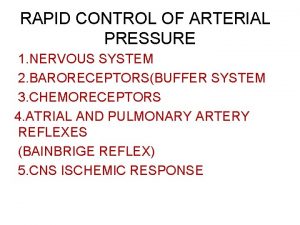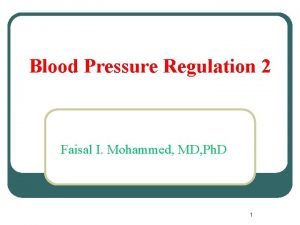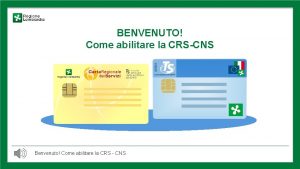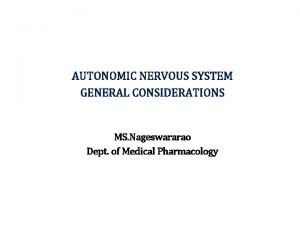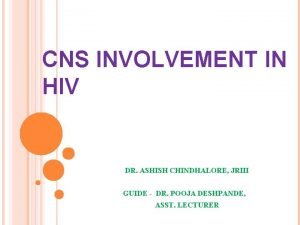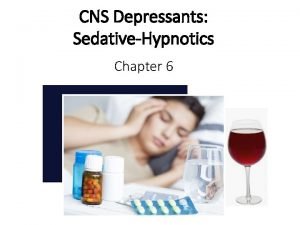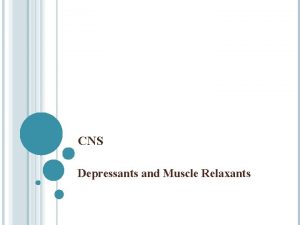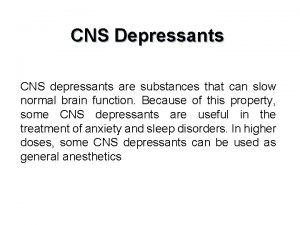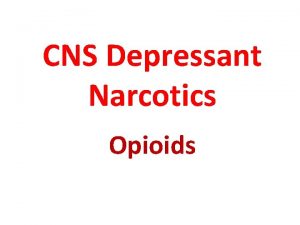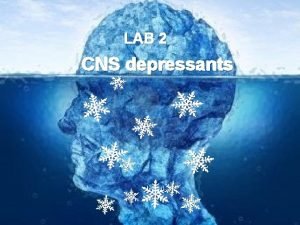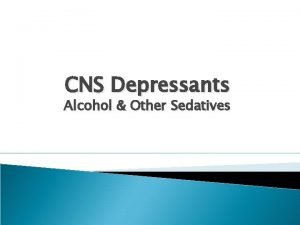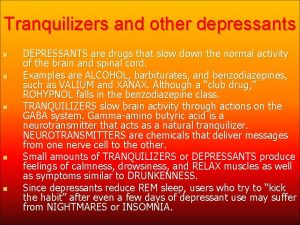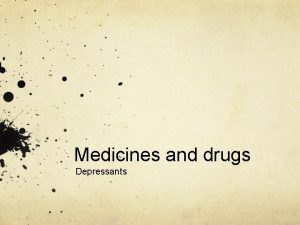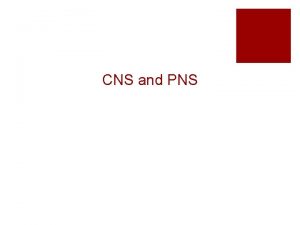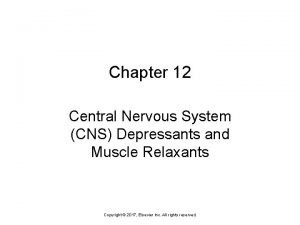CNS Depressants SedativeHypnotics Chapter 6 PPT Series 6














- Slides: 14

CNS Depressants: Sedative-Hypnotics Chapter 6 PPT Series 6 B

Types of CNS Depressants: Nonbenzodiazepines (small section in textbook “New Generation Sleep Aids, p. 196) Also named Z-drugs, nonbenzodiazepine GABAa agonists, used as hypnotics. Nonbenzodiazepines drug actions are the same as benzodiazepine drugs and therefore employ similar benefits, side-effects, and risks, but this class of drugs is different from benzodiazepines at the molecular level. Examples of nonbenzodiazepines include Ambien (Zolpidem) and Lunesta (Eszopiclone) and Sonata (Zaleplon)

Types of CNS Depressants: Barbiturates are barbituric acid derivatives used therapeutically as sedatives, anxiolytics, hypnotics, and anticonvulsants that have a narrow margin of safety and high abuse potential. Barbituric acid was first discovered by the German chemist Adolf von Baeyer in 1864. The first barbiturate, Barbital (Veronal: named after the Italian city of Verona), was medically used in 190304, initially to treat mental illness(treatment of patients with serious neuroses and psychoses and with severe emotional repression), and as a general hypnotic drug. Although over 2500 barbiturates have been synthesized, 50 were approved for human use, and only few remain in therapeutic use due to serious side effects, high risk for dependency and a narrow margin of safety

Types of CNS Depressants: Barbiturates Uncontrolled use of Barbiturates cause a state of intoxication (both acute and chronic), change in behavior, loss of inhibition and euphoria. Barbiturate intoxication also presents emotional instability, problems in decision making, problems in motor control, and slurred speech (similar to the symptoms of ethanol consumption). When used as a sleep aid, Barbiturates inhibit REM sleep, where the user wakes up feeling agitated, and unsatisfied. Continued use of barbiturates has a cumulative toxic effect on the CNS, and when taken with other CNS depressants can cause sudden cardiorespiratory depression and death. Repeated misuse of Barbiturates induces severe tolerance and dependence. Rapid withdrawal of an abusive can cause life threatening seizures.

Types of CNS Depressants: Barbiturates Effects and Medical Uses Used therapeutically as sedatives, anxiolytics, hypnotics, and anticonvulsants by suppressing CNS and actions are dosedependent. Because liver enzymes biotransform barbiturates, excess use can cause liver damage, and correspondent liver damage can allow for a more pronounced effect of barbiturates. Major problems with therapeutic use of barbiturates includes: 1) lack of selectivity and safety; 2) a substantial tendency to create tolerance, dependence, withdrawal, and abuse; and, 3) problems with drug interaction. As a result barbiturates have been replaced by benzodiazepines in most therapeutic treatment regimens. Barbiturates are mostly used therapeutically as preoperative anesthetics, and anticonvulsants

Types of CNS Depressants: Barbiturates Mechanism of Action and Elimination Barbiturates mechanism of action occurs through positive allosteric modulation (PAM) agonists of GABAa receptors (not GABA, but activates receptors) thus causing inhibition at the receptor site (see Table, p. 144, text). This binding action down regulates the activity of the Reticular Activating System, the Limbic System, and the Motor Cortex, which explains the symptoms of acute barbiturate intoxication.

Other Types of CNS Depressants: Chloral Hydrate Chloral hydrate is a sedative and hypnotic, and has a narrow margin of safety It was discovered in 1832 by Justus von Liebig, and widely used for sedation in asylums later in the 19 th century. Chloral hydrate is soluble in both water and ethanol. A solution of chloral hydrate in ethanol called "knockout drops" was used to prepare a “Mickey Finn” or knock out drops Acute over dosage is often characterized by nausea, vomiting, confusion, convulsions, slow and irregular breathing, cardiac arrhythmia, and coma. Chloral hydrate has not been approved by the FDA.

Other Types of CNS Depressants: Methaqualone was first introduced as an antimalarial drug in the 1950 s. Methaqualone’s brand name Quaalude (“ludes or sopers”) and Mandrax, was used as sedative and hypnotic. Methaqualone increases the activity of the GABA receptors Peak use was in the late 1960’s and early 1970’s for the treatment of insomnia, and as a sedative and muscle relaxant. After years of “street abuse” the drug was removed from the market and not manufactured in the U. S. since 1985. Side effects include diarrhea, sweating, dry mouth, depersonalization, headache, paresthesia, and hangover.

Other Types of CNS Depressants: Antihistamines are medications that block Histamine H 1 receptors. Sedation is a common side effect of H 1 antihistamines that readily cross the blood–brain barrier; drugs such as diphenhydramine can promote sleepiness (hypnosis). Exact mechanism for action of antihistamines as CNS depressants is unclear, but believed to block ACH (acetylcholine) activity in the brain causing sedation. Antihistamines also have the potential to produce paradoxical effects: restlessness, agitation, and insomnia. Common side effects include dry mouth, thus chronic use can promote dental cavities, gum disease, and halitosis.

Other Types of CNS Depressants: Propofol was initially available in 1986 and used intravenously for rapid sedation anesthesia (fast acting) , and acts on GABA receptors. In addition to sedation, the user may experience stress relief, euphoria Side effects include an irregular heart rate, hypotension, amnesia, and respiratory slowing. Serious side effects may include seizures, infections with improper use, addiction, and propofol infusion syndrome with long-term use

Other Types of CNS Depressants: GHB • GHB (gamma hydroxybutyrate) is a colorless, tasteless substance that occurs naturally in the body from the metabolism of GABA, and may enact GABA and/or independent GHB receptors in the brain • GHB has been used as a club drug (euphoriant) and believed to be aphrodisiac. GHB also produces sociability (empathogen / entactogen) and heralded for a hang-over free “high”. • GHB can be easily mixed in a cocktail drink and is tasteless and odorless, and at increased doses causes drowsiness, forgetfulness, and loss of muscle tone, hence used as a “date rape drug” like rohypnol. Victims are typically unable to recall details of the attack, and the use of GHB is difficult to prove as half-life is within 34 hours after ingestion

Patterns of Abuse with CNS Depressants CNS depressant Substance Use Disorder (APA) can be diagnosed when symptoms include: (p. 198, text)

Patterns of Abuse with CNS Depressants Principle behaviors associated with Depressant SUD (p. 198, text): In general, chronic abusers prefer: 1) short acting barbiturates, 2) barbiturate-like depressants, or, 3) fast acting benzodiazepines

Treatment for CNS Depressants Treatment for chronic dependency requires detoxification (The elimination of a toxic substance, such as a drug, and its effects) • Withdrawal symptoms include anxiety, tremors, nightmares, insomnia, anorexia, nausea, vomiting, seizures, delirium, and maniacal activity. • With Short-acting depressant addiction, onset of symptoms is more rapid and severe. • With CNS depressants, this is achieved by substituting a longeracting barbiturate for the offending CNS depressant and gradually reducing the dose to avoid unpleasant withdrawal effects. Withdrawal from CNS depressants, if not managed properly, can be very dangerous, or even fatal The American Psychiatric Association considers dependence on CNS depressants a psychiatric disorder. END of PPT Series 6 B
 Cns depressants ppt
Cns depressants ppt Cns depressants classification
Cns depressants classification Cardiac stimulants and depressants
Cardiac stimulants and depressants Depressants affect the__________.
Depressants affect the__________. Site:slidetodoc.com
Site:slidetodoc.com Cns2779-1
Cns2779-1 Naas community national school
Naas community national school Cns ischemic response
Cns ischemic response Composition of cns
Composition of cns Cns ischemic response
Cns ischemic response Cns ischemic response
Cns ischemic response Atrail
Atrail Www.lispa.it cns
Www.lispa.it cns Ans and cns difference
Ans and cns difference Cns
Cns
